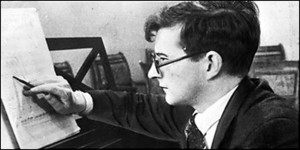It goes without saying that great music has the potential to transport us to a different world – a world with its own sense of style, preferred colors, and points of view. A painting by Monet blurs our vision and wraps us in washes of color. In his world, the emotional truth needs no defined lines. A film by Pedro Almodovar shows us a vibrant, edgy world where we’re sure to see red. In his world, we might feel slapped in the face by reality.
 The sound-world that I was immersed in this past week was that of Dmitri Shostakovich – his Fifth Symphony, to be exact. It is a breathtaking piece and beautiful in a raw kind of way. It is sometimes terrifying, sometimes heartbreaking, and every so often it shimmers with glimmers of hope. It is pure genius to me that the angularity of Shostakovich’s musical language manages still to be lyrical and expressive. It is open and transparent in its structure without being simple. For me, there are few things more truly awesome than sitting on stage in the middle of this music.
The sound-world that I was immersed in this past week was that of Dmitri Shostakovich – his Fifth Symphony, to be exact. It is a breathtaking piece and beautiful in a raw kind of way. It is sometimes terrifying, sometimes heartbreaking, and every so often it shimmers with glimmers of hope. It is pure genius to me that the angularity of Shostakovich’s musical language manages still to be lyrical and expressive. It is open and transparent in its structure without being simple. For me, there are few things more truly awesome than sitting on stage in the middle of this music.
I came to know his music through the horn initially, of course. A few of our most (in)famous audition excerpts are in this piece. His cello concerto also has a prominent solo horn part, and the horn is a prominent presence in most of his orchestral works.
That being said, I love his non-orchestral work too. I had the good fortune of studying piano in college with a teacher who knew just what to choose for me to play as a non-piano major with horn ambitions. He chose several of Shostakovich’s piano preludes (op. 34) for me to learn. One of my very favorites is no. 14 in E-flat minor. It is haunting and anguished, a mood not unlike parts of the Fifth Symphony. Several other of the preludes are more jaunty and seem to poke fun. Others are wry and whimsical.
If you are ever interested in some good stories about how music and politics might intersect, Shostakovich’s life might be an interesting one to study. His relationship with the Stalinist regime is fraught with drama and intrigue. Even his memoirs (Testimony: The Memoirs of Dmitri Shostakovich by Solomon Volkov) have served as a lightening rod, spurring controversy over the composer’s life and motivations.
As juicy as the intrigue is, the juiciest place of all is in the sound-world that Shostakovich creates. Here are a few of those piano preludes I mentioned – minus my favorite one. You’ll have to look that up on your own as well as the Fifth Symphony if you don’t already know it. Enjoy!
